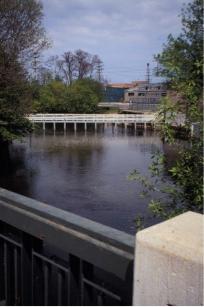 |
|
|
||||
| Michigan Water Science Center |
|
Project Chief Sheridan Haack Statewide Water Resources Monitoring Protection of Drinking Water Sources Effects of Land Use on Water Quality
Restoring Natural Flow Regimes Research and Technical Assistance at Contaminated Sites Table of Contents |
 The Boardman River in an urban region of the Grand Traverse Bay Watershed.
The USGS has a continuing collaboration with faculty at Michigan
State University (MSU; David W. Hyndman and David T. Long, Department
of Geological Sciences; Bryan C. Pijanowski, Department
of Entomology) to relate land use and land use change to water quality
in the Grand Traverse Bay Watershed, MI.
The USGS component of this collaboration addresses how land use affects the
occurrence and distribution of E. coli bacteria, chemical indicators
of human pollution such as caffeine and cholesterol, and recently, the presence
of specific pharmaceutical compounds. In collaboration with
MSU
, the USGS has (1) sampled up to 35 sites for coliform and E. coli
bacteria on 7 dates over four years; (2) analyzed the DNA fingerprints of
335 E. coli bacteria taken from these sites and antibiotic resistance
patterns for 95 of these, and shown relations between land use and sampling
date and the types of E. coli found; (3) evaluated sampling methodologies
and spatial scales required for optimum E. coli DNA fingerprint detection;
and (4) detected indicators of pharmaceutical compounds (caffeine, cholesterol,
nonylphenols, plus other constituents) at selected watershed sites on multiple
dates. We have recently begun to incorporate this information into GIS and
hydrologic models developed by our MSU collaborators.
 The Boardman River in a rural region of the Grand Traverse Bay Watershed.
In addition, at the request of the Grand Traverse County Public Health Department, we have recently sampled water and sediments at county beaches to provide background information on microbial pollution at these sites, using new methods proposed for beach monitoring by the USEPA. This prior and current work allows us to relate microbial and emerging-contaminant pollution of waters in the Grand Traverse Bay Waterhsed to (1) land use, (2) possible source and (3) hydrologic conditions and to predict trends in these parameters as land use changes occur.
References:
Haack, Sheridan K., Wilson, Jeffrey S., Woodhams, Sarah M., Long, David T., Pijanowski, Bryan C., Boutt, David F., and Hyndman, David W. 2000. Abundance, dissemination, and diversity of Escherichia coli in a watershed in northern Michigan, USA. In F.D., Britton, L.J., Miller, C.V., and Kolpin, D.W., compilers, 2000, Effects of animal feeding operations on water resources and the environment--proceedings of the technical meeting, Fort Collins, Colorado, August 30-September 1, 1999: U.S. Geological Survey Open-File Report 00-024, 107 p. Haack, S. K. 2000. A national reconnaissance of pharmaceuticals and other emerging contaminants in U.S. streams. State of the Lakes Ecosystems Conference. October 17-19, 2000, Hamilton, ON, Canada.
Haack, Sheridan K., Underwood, Joel R., and Reynolds, Lisa A. 2001. Escherichia coli and enterococci at beaches in Grand Traverse Bay, MI: relation to environmental and hydrologic factors. USEPA Beach Conference, February 6-8, 2001, Chicago, IL |